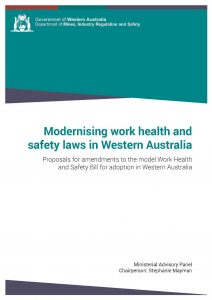Western Australia’s Parliament heard more about the State’s investigation into work-related mental health on June 26 2018.
Author: Kevin Jones
Western Australia opens consultation on WHS laws
 On June 28 2018 in the West Australian Parliament, the Minister for Commerce and Industrial Relations, Bill Johnston, progressed the State’s move to towards harmonised Work Health and Safety (WHS) laws. According to Hansard, Johnston said
On June 28 2018 in the West Australian Parliament, the Minister for Commerce and Industrial Relations, Bill Johnston, progressed the State’s move to towards harmonised Work Health and Safety (WHS) laws. According to Hansard, Johnston said
“Last July, I formed a ministerial advisory panel to advise on the development of a single, harmonised and comprehensive work health and safety act. The new act will cover all workplaces in Western Australia and be aligned with legislation in other Australian jurisdictions…..” (page 4146, emphasis added)
That WA will have new safety laws to cover all workplaces is a very good move;
Talking about OHS could remove the need for Industrial Manslaughter laws
Gaby Grammeno has been writing about workplace health and safety (WHS) issues for longer than I have. Her work for Workplace OHS, a subscription OHS news service, includes an “ask an expert” service and her latest is a comparison between the OHS/WHS laws involving “reckless endangerment” and “industrial manslaughter”.
The article is of interest to OHS people and reinforces some of the legal opinions on the proposed introduction of industrial manslaughter laws in Victoria. There is disparity in sentencing and financial penalties in Queensland laws compared to potential Victorian ones and one includes “serious injuries” where the other addresses deaths. But the issue of penalty sizes is a sideshow to the intended purpose of these types of laws – deterrence.
Will a penalty of A$3.8 million have a greater deterrent effect than A$3.1 million?
Dreamworld – this week and beyond
 Managerial representatives of Dreamworld appeared at the second week of the inquest into the deaths of four patrons at the Australian theme park in 2016. The week ended with Dreamworld’s parent company Ardent Leisure advising the Australian Securities Exchange of the departure of the current Chief Executive Officer, Craig Davidson. So what does this all mean?
Managerial representatives of Dreamworld appeared at the second week of the inquest into the deaths of four patrons at the Australian theme park in 2016. The week ended with Dreamworld’s parent company Ardent Leisure advising the Australian Securities Exchange of the departure of the current Chief Executive Officer, Craig Davidson. So what does this all mean?
Safety Management
Early last week, Dreamworld’s former safety manager, Mark
Three books that challenge OHS
Book publisher Routledge has recently released books about occupational health and safety (OHS) that are very critical of OHS’ role, or that of the health and safety professional, in modern business. Below I dip into the
- The Fearless World of Professional Safety in the 21st Century
- The 10 Step MBA for Safety and Health Practitioners, and
- Naked Safety – Exploring The Dynamics of Safety in a Fast-Changing World.
Labour Hire safety challenges
Victoria has passed legislation to licence the labour hire industry. Occupational health and safety (OHS) gets a mention, in some ways.
The objects of this Act seem fairly straightforward:
- ” to protect workers from being exploited by providers of labour hire services and hosts; and
- to improve the transparency”
The explanatory memorandum sounds promising. Clause 23 says:
“Subclause (1) states that if an application for a licence or renewal of a licence is made by an applicant who, at the time of making the application, is conducting a business that provides labour hire
services, the applicant must include with the application a declaration that, to the applicant’s knowledge, the applicant complies with the various laws that are set out so far as they relate to the business to which the licence relates. Examples of
such laws include workplace, taxation and occupational health and safety laws.”
The good news is that OHS is stated as an example of the type of information required in a licence application.
Read widely, carefully and analytically.
 One of the most rewarding sources of occupational health and safety (OHS) information is the literature review undertaken by, usually, university researchers. It is rewarding because someone else has done most of the reading for you and the spread of resources can be massive and/or global. But, there can also be missed opportunities from taking a narrow scope and from excluding some non-peer-reviewed analysis. One of these involves a systematic review of lost-time injuries in the global mining industry.
One of the most rewarding sources of occupational health and safety (OHS) information is the literature review undertaken by, usually, university researchers. It is rewarding because someone else has done most of the reading for you and the spread of resources can be massive and/or global. But, there can also be missed opportunities from taking a narrow scope and from excluding some non-peer-reviewed analysis. One of these involves a systematic review of lost-time injuries in the global mining industry.
